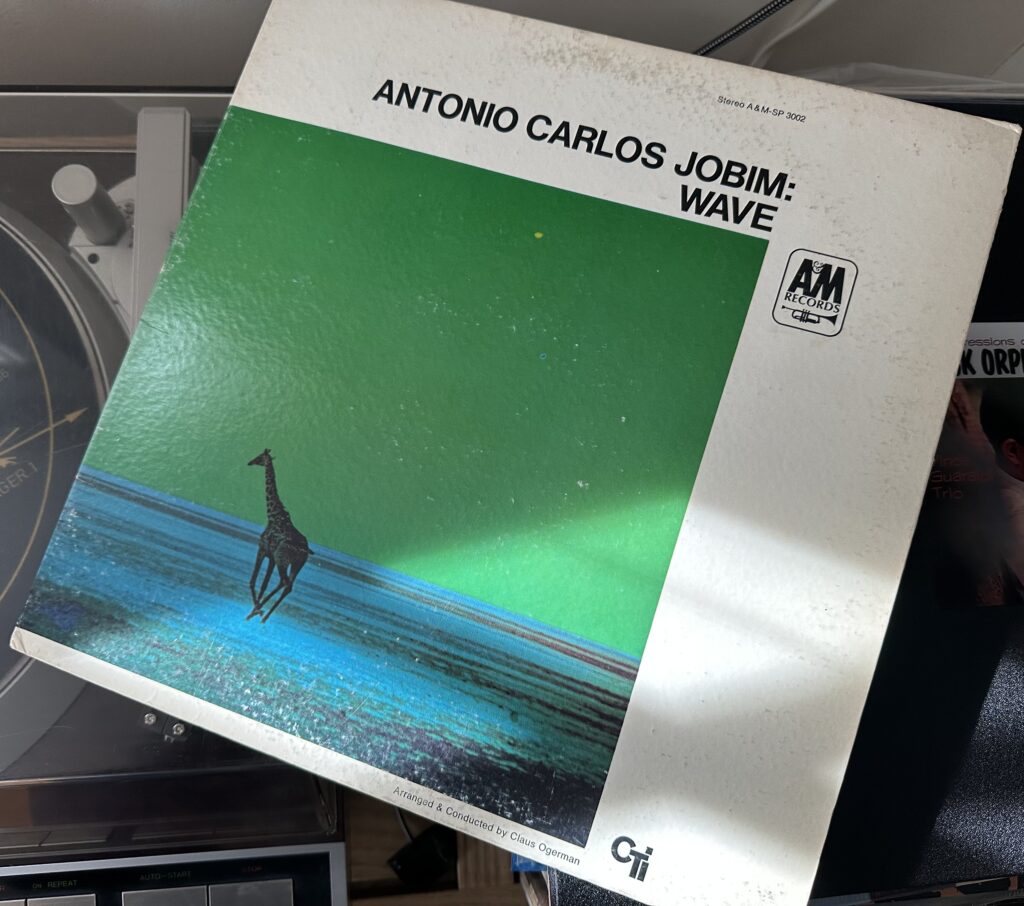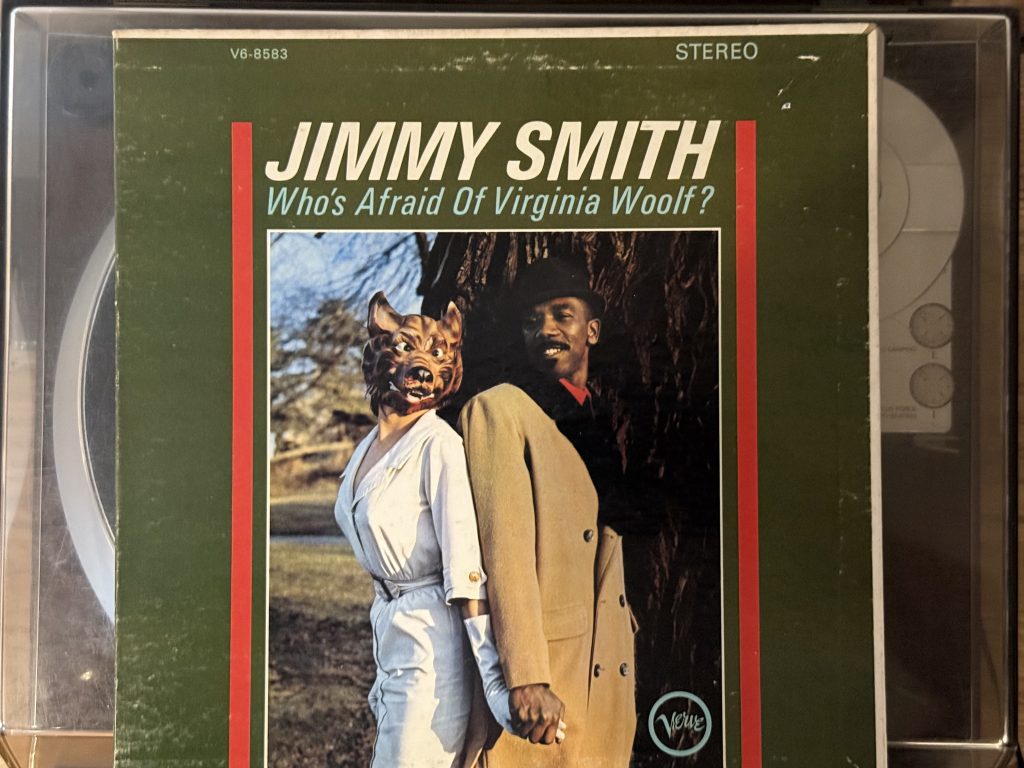
Album of the Week, August 16, 2025
I mentioned when writing about The Cat, Jimmy Smith’s 1964 Verve album with Lalo Schifrin, that it wasn’t his only album released for Verve that year. That might understate the weirdness of Who’s Afraid of Virginia Woolf? just a little bit. Not only did the album come the same year, and not only did it also pair the great jazz organist with a renowned composer/arranger (or two!), but the title songs for both records bear a certain… relationship to one another. In fact, as the late lamented Professor Peter Schickele would say, “The name of that relationship is identity.”
I’m not quite sure how it is that “Who’s Afraid of Virginia Woolf” and “The Cat” got to have an identical orchestral arrangement, but in other ways the two records, conceptually similar on paper, are very different. To begin with, The Cat is still an organ trio album, albeit with lots and lots of horns. Who’s Afraid of Virginia Woolf is really an orchestral pop album with a jazz organ soloist. And it was arranged by two of the best. We’ve written about Claus Ogerman before, in his later work with Verve and Creed Taylor on Antônio Carlos Jobim’s Wave. And Oliver Nelson, who arranged the first side of the record, would be well known as a jazz composer and arranger even without a great 1961 album he cut with Creed Taylor on Impulse… but that’s a story for another time. Also joining, though not credited, were the same rhythm section as The Cat—George Duvivier on bass, Grady Tate on drums, and Kenny Burrell on guitar. Photographer Roy DeCarava is credited with the nightmarish cover; since he also photographed Miles’ version of Porgy and Bess, Bill Evans’ Conversations with Myself, and Branford Marsalis’ Renaissance, among other masterworks, we can only assume that someone put him up to it. The maker of the wolf’s head is uncredited.
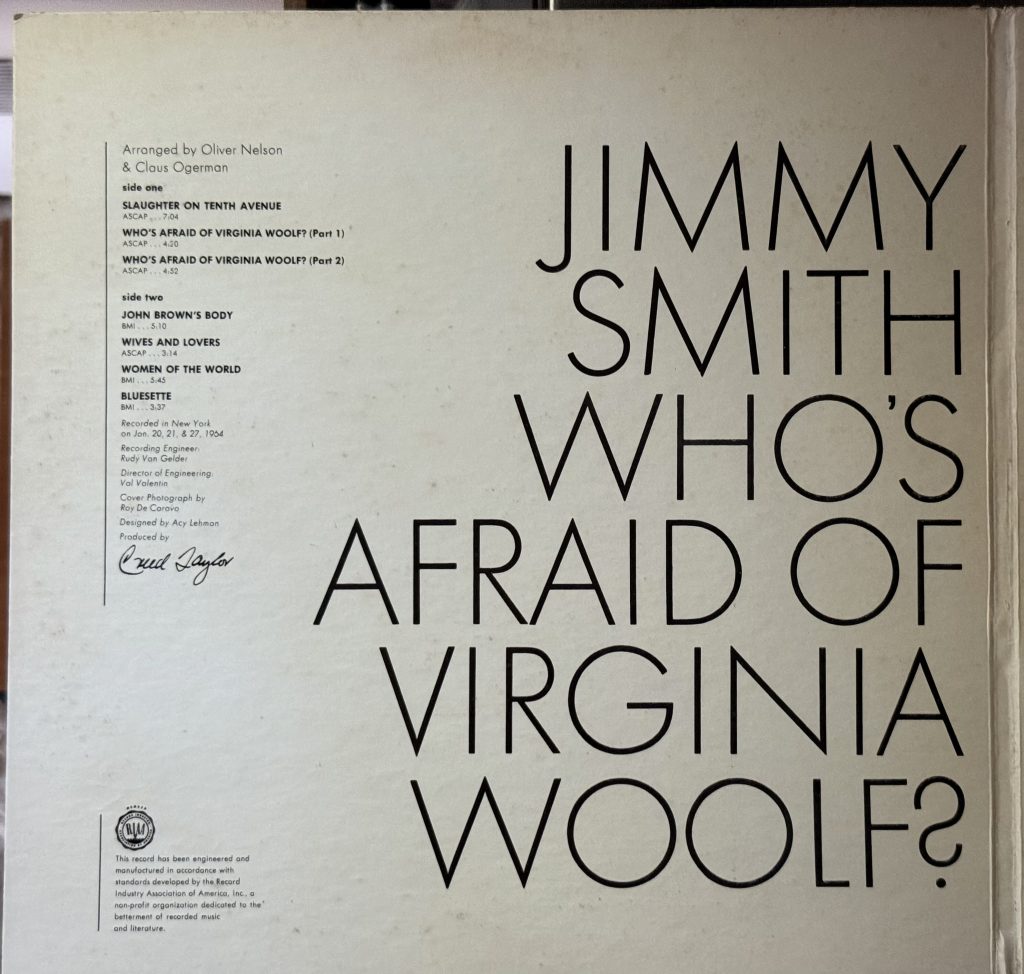
“Slaughter on Tenth Avenue” opens the record with an expansive Oliver Nelson arrangement of the Richard Rodgers ballet score. There’s a lot going on in the first few seconds—intelligent use of lower brass and woodwinds, a pointillistic xylophone, thundering timpani. The tuba and low trombone give us an ominous introduction to Jimmy Smith stating the theme on the Hammond. And the horns give us the great chorus hook, the syncopated III – V – III – V – VI – V – III melody that then sets up Smith’s solo. This is where the arrangement really takes off, as it swings into a fast 6/8 that climbs into the stratosphere, pushing Smith to high riffs and flourishes as the orchestra plays the theme slowly behind him. The end seems to dissolve in spreading rings of dissonance as the timpani and drums beat louder and louder, until the orchestra finally brings us to closure with a diminished seventh chord. It’s quite a transition…
…into a very familiar theme. “Who’s Afraid of Virginia Woolf?” (parts 1 and 2), composed by jazz pianist Don Kirkpatrick, opens with a version of the same flourish as “The Cat,” here treated with slightly more care and less mayhem than Lalo Schifrin’s arrangement. If Nelson’s arrangement and tempo takes some of the edge off the theme, Smith puts the edge right back. Indeed, though there are some fantastically crunchy chords from the orchestra, Part 1 seems at its best when it’s just the interchange between Smith, Burrell, and Tate. The orchestra seems invigorated by the long collective improvisation when they return, and Smith returns the favor, with a rippingly fast improvisation that takes it right up to the end. Part 2 is even more intriguing, with a bouncy drums and claves introduction leading into a trumpet statement of the theme, then a groovy solo turn by Smith that’s notable for how much space is left to appreciate that ongoing groove. Another wall of dissonance (one imagines Smith pulling out a bunch of stops and leaning on the keyboard) transitions into a more active solo with punctuation from the horns. As the second part draws to an end, it seems to circle back to something more like the Part 1 arrangement, closing with the full arrangement of the hook and one more high velocity solo, in a sort of ecstatic exhaustion.
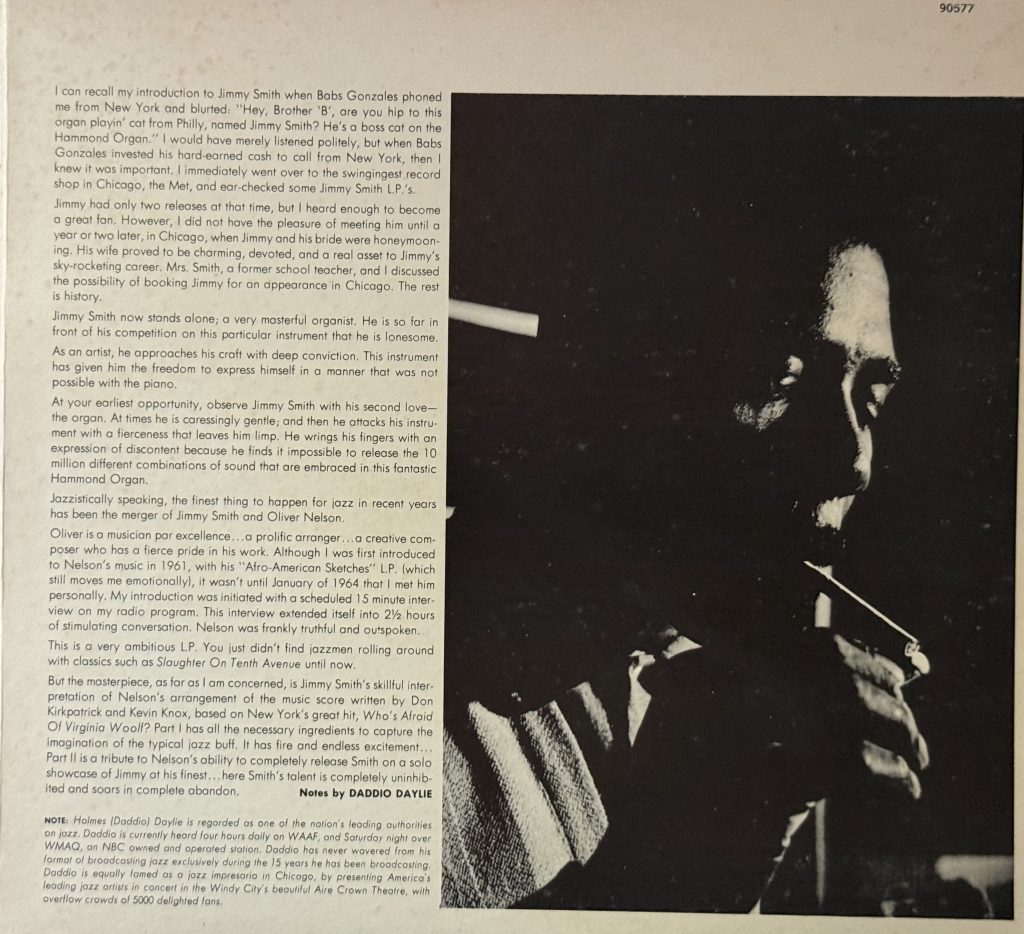
“John Brown’s Body” gets a throbbing introduction from the low brass before Smith gives us an offbeat statement of the famous theme. There’s a little more air in this Claus Ogerman arrangement, with enough room around the brass for Kenny Burrell to contribute the occasional stab of a chord to move things along, then to play alongside as a sort of persistent Greek chorus. Grady Tate’s unshowy timekeeping is an understated star here; it’s only as he sneaks an occasional cymbal hit in around the edges that you really hear his steady genius at work. Ogerman brings the jam to a slow fade-out; you can imagine the band going on here ad infinitum.
“Wives and Lovers” returns us to a slow swing, with the melody stated in the winds, as Jimmy plays the Burt Bacharach melody down in the baritone range of the organ. This is a brief arrangement that is mostly about hearing Smith’s melodic imagination work its way around the brilliant Bacharach chords; Ogerman seems content to fade this one out, perhaps to get to “Women of the World” faster. This sixties pop groover by Riziero Ortolani is given a samba backbeat by Grady Tate, but seems to circle around the melody without much motion. Smith makes the most of the slim material, accelerating into a faster tempo in the midst of his solo and urging the percussionists and Tate to follow, before drawing it to a mantra-like close.
“Bluesette” closes us out with a swinging rendition of the 1962 Toots Thielemans hit. Jimmy keeps the solo in a slightly higher register, perhaps to echo Thielemans’ whistling melody, as he rips into an extended solo following the brief orchestral introduction. Tate and Burrell cook right along with him through the improvisation. When the orchestra comes back in, they take us to a coda of sorts, staying suspended on a minor third to fourth riff as Jimmy heads right off into infinity.
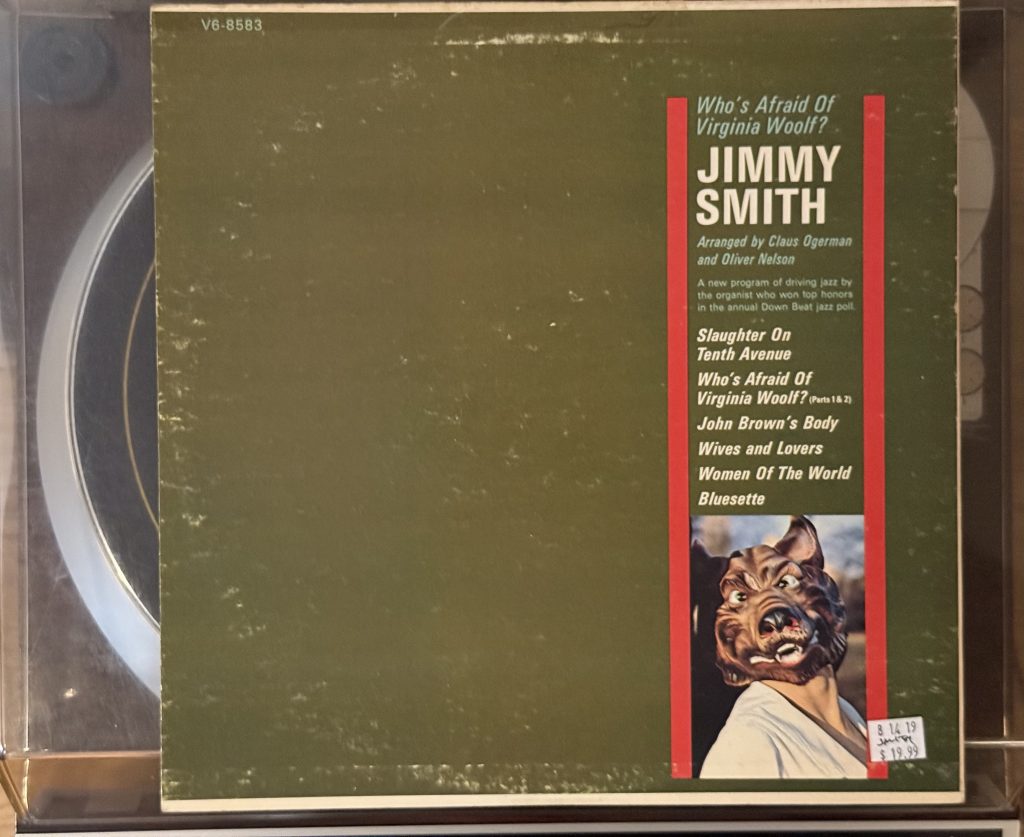
There’s no disputing that the work Smith did with Nelson and Ogerman, as well as Lalo Schifrin, expanded his sound; there are some purists who would use a more pejorative verb in that sentence. But as we’ve heard, there are pleasures to be had from the combination of the well-crafted arrangements with Smith’s impeccable organ playing. Incredibly, this album and The Cats weren’t the only two albums the incredibly prolific Smith recorded in 1964; they were perhaps not even the best-known of those albums. But we’re going to save his last 1964 selection for another time. Next week will find us with an album from the following year that saw him returning to a more familiar configuration, with spectacular results.
You can listen to this week’s album here:
BONUS: Here’s Smith playing the title track live in 1965 with Quentin Warren on guitar and Billy Hart on drums:
BONUS BONUS: Following its release on this album, “Who’s Afraid of Virginia Woolf” was covered by a variety of artists, including this memorable instrumental cover by James Brown’s band, with none other than Brown himself at the keys:

